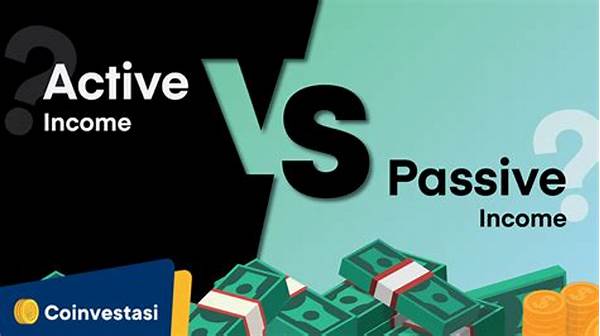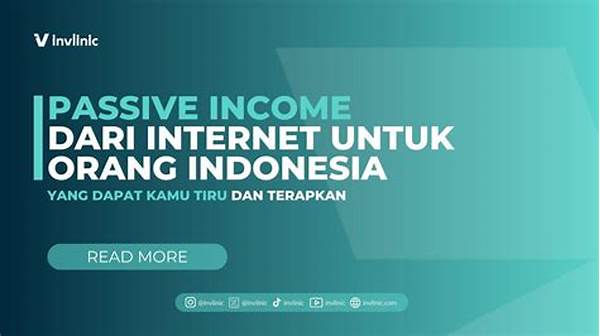
In today’s fast-paced world, understanding the streams of income and how they differ is crucial for anyone looking to achieve financial stability or independence. It’s no longer enough to have just one source of income; rather, having a diversified portfolio can be the key to financial success. Two popular forms of income are passive income and active income, and knowing the difference can change how you approach money management. Imagine waking up in the morning, and even before you’ve stepped out of bed, your bank account is richer than it was the night before—that’s passive income working for you. In contrast, active income demands your time and energy, where every dollar earned is directly tied to hours worked. This article will delve into the distinctions between these income types, providing insight into how each can be integrated into your personal financial plan.
Read More : The Ultimate Investment Secret: How To Use Dividend Stocks To Pay Your Monthly Bills!
When hearing about passive income, streams such as dividends, rental income, or even income from a business where you aren’t actively involved might come to mind. This type of income allows for financial freedom since it lets money work for you rather than you working for money. On the flip side, active income involves more traditional methods of earning, like a 9-to-5 job or freelancing gigs where your presence and effort are needed to see returns. Although both types have their pros and cons, they cater to different lifestyle choices and financial goals. Understanding the difference between passive income and active income can help tailor your approach to wealth generation and management.
Developing a deep understanding of these income streams involves more than just knowing their definitions. It’s about appreciating how they align with your life goals and ambitions. Whether you’re an entrepreneur with a start-up idea, a professional pondering retirement plans, or someone exploring side hustles, grasping the periphery between passive and active income could be your ticket to a more rewarding financial life. So, let’s embark on this journey to uncover how these income forms can shape your economic landscape and bring you closer to achieving a balanced and abundant lifestyle.
Exploring Passive Income and Active Income
In the pursuit of wealth, income plays a vital role. The difference between passive income and active income isn’t just economic; it’s philosophical. Active income is the straightforward, albeit time-consuming, path where your efforts equivalent the financial output. The more you work, the more you earn. It’s as if you’re on a financial treadmill, and you must keep running to stay in place.
However, with passive income, you set off a chain reaction—a smart investment, a creative endeavor, or a strategic business—that liberates your time while ensuring continued financial flow. Instead of a treadmill, think of it as planting a tree. Once the roots are established, it grows, providing shade and fruit with minimal intervention from you. This metaphor perfectly illustrates the contrasts and the strategic choices individuals must make regarding their income sources.
The real charm of passive income lies in its potential to offer financial freedom. Whether through real estate, dividends, or digital product sales, it encapsulates leveraging assets to produce value. Active income requires full engagement. It demands passion and dedication, challenging your abilities and driving you to expand your skills.
The modern financial landscape encourages a combination of both. By recognizing the difference between passive income and active income, you invest in a secure future while enjoying the vitality of the present. Whether you’re the tree planter wanting sustainable growth or the committed professional focusing on active achievements, understanding these dynamics equips you to make informed financial decisions.
As you navigate your financial journey, embracing the balance between these income forms could be the answer to achieving both security and freedom. With a touch of humor and some strategic planning, let your financial story unfold, enriched by the diverse ways you can earn and grow wealth.
Key Components of Income Streams
Passive income and active income form the pillars of financial planning. Active income is direct. You commit hours; you receive payment. In contrast, passive income is like a seed planted once but helps perpetuate continuous growth. The journey between managing these income sources, filled with challenges and insights, is unique for everyone. By understanding the strengths of each, you’re one step closer to financial enlightenment.
Understanding Income Differences
The variance in passive income and active income isn’t just about money—it’s about lifestyle choice. It’s about deciding how you want your days to look, choosing between a constant hustle or setting achievable procurement goals. Each pathway has its audience, and the key is discovering which resonates with your objectives and aspirations.
Seven Goals Related to Income Differences
Understanding the difference between passive income and active income is crucial to modern financial success. Here are seven goals to work toward:
A balanced blend of passive and active income provides financial stability, ensuring that if one stream falters, others can support you.
Passive income is often heralded as the pathway to financial freedom, enabling a life less dependent on constant work and more focused on experiences.
By combining both income streams, you open up avenues to maximize your earning potential, utilizing all your assets effectively.
Passive income can build wealth that lasts, establishing a financial legacy that can support future generations.
Access to passive income can significantly enhance work-life balance, providing choices and reducing stress related to financial pressures.
Active income often requires developing new skills and expanding expertise, promoting continual personal growth.
Diversified income lowers financial risks by spreading your earnings across multiple avenues, providing a safety net against economic downturns.
By pursuing these goals, you solidify your financial journey, embedding security and opportunity within your roadmap to success.
Passive vs. Active: Comparative Insights
Passive income and active income each have unique advantages and challenges. Active income often requires immediate effort and is subject to a cap based on time and energy. Conversely, passive income, once established, can generate ongoing earnings with minimal additional input. The strategic use of both can lead to a more robust and resilient financial portfolio, allowing for economic growth, freedom, and stability.
Strategic Financial Planning
Integrating both income types into personal financial strategy encourages diversity and promotes resilience, capable of weathering economic fluctuations and life changes. The effective use of both can elevate your financial landscape from a static dependency on labor to an encompassing embrace of income-generating assets and initiatives.
Understanding these differences and implementing a balanced approach can perpetuate financial growth, offering both immediate rewards from active endeavors and future security from passive income sources. Whether you’re planting seeds for future gains or scaling a career ladder, knowing how to navigate these income streams is pivotal to achieving sustained financial health and freedom.


